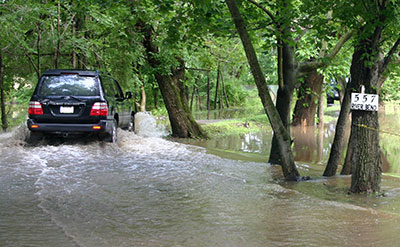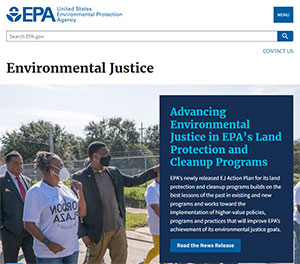Social Equity — Environment
The impact of environmental conditions in disadvantaged communities is one of the oldest recognized topics relating to social equity. It became more prominent in 1982 when the residents of Warren County, NC, which had the highest percentage of African American in the state, organized to opposed construction of a new dump for polychlorinated biphenyls (PCBs) as a result of racial bias. Since then, the discussion of environmental degradation impacting disadvantaged communities has expanded to include features like heat islands, flooding, and access to parks and natural areas.
Some useful websites that address this issue include:
- US Environmental Protection Agency, Equitable Development and Environmental Justice
- University of New Mexico: UM Newsroom, The Complicated History of Environmental Racism
- New York Times, Pollution Is Killing Black Americans. This Community Fought Back.
- US Department of Energy, Environmental Justice History
View mapping illustrating social equity and the environment in Chester County. This mapping addresses surface temperature; landfill and abandoned landfills; waste facilities; and superfund sites.
Heat Islands and Cooling Centers
Heat islands are locations, usually in highly developed areas, that experience higher ambient temperatures than surrounding areas. Impervious areas such as buildings, roads, and other infrastructure absorb and re-emit the sun's heat more than naturally vegetated landscapes such as forests and fields. Disadvantaged communities located in setting that are highly paved are more likely to experience higher temperatures during extreme summer events. This can have a major impact on seniors who are less likely to own air conditioners or go outside. As a result, access to cooling centers is an intrinsically related issue.

Source: DVRPC "Figure 9: Heat Islands — DVRPC Region (2014-2017)" in Municipal Management of Extreme Heat, May 2021.
Some useful websites that address this issue include:
- US Environmental Protection Agency: Heat Island Effect
- US Environmental Protection Agency: Heat Islands and Equity
- New York City, Comptroller: Overheated, Underserved, Expanding Cooling Center Access
- US Centers for Disease Control and Prevention: The Use of Cooling Centers to Prevent Heat-Related Illness
Access to recreational parks and natural areas
 Access to parks and recreation is an important social equity issue that is somewhat more complex than it may seem. At the most basic level, parks and natural areas must be physically accessible, ideally through trails or sidewalks that can be used by preteens and teenagers who could walk or ride bicycles to the parks without constant adult supervision. But often overlooked aspects of parks and recreation are recreational programing, maintenance, and security. These services require ongoing funding for staff and materials. In economically distressed communities, there may be acres of public parkland, but that land cannot adequately serve its surrounding community due to insufficient funding for maintenance and security.
Access to parks and recreation is an important social equity issue that is somewhat more complex than it may seem. At the most basic level, parks and natural areas must be physically accessible, ideally through trails or sidewalks that can be used by preteens and teenagers who could walk or ride bicycles to the parks without constant adult supervision. But often overlooked aspects of parks and recreation are recreational programing, maintenance, and security. These services require ongoing funding for staff and materials. In economically distressed communities, there may be acres of public parkland, but that land cannot adequately serve its surrounding community due to insufficient funding for maintenance and security.
Some useful websites that address this issue include:
- National Recreation and Parks Society: Social Equity and Parks and Recreation
- Bloomberg Philanthropies: 5 Questions on the important role parks can play in social equity
- American Planning Association: Parks Are an Equity Issue
- Urban Institute: Five Ways to Center Equity in Park and Recreation Spending That Can Help New Funding Go Further
Climate Impact
Recently, the impact of climate change on disadvantaged communities has become the focus of an increasing number of studies and initiatives. The reason for this interest is that climate change has resulted in an increase in localized temperature and weather extremes. Heat waves and cold spells have significant impacts on communities where there are a preponderance of homes lacking effective insulation or air conditioning. Extreme weather can also cause flooding which is more likely to impact older neighborhoods that were constructed in floodplains prior to modern floodplain avoidance regulations.
Some useful websites that address this issue include:
- Washington APA: Social Equity & Climate Change
- The Lancet: Climate change, health, and discrimination: action towards racial justice
- NAACP: Environmental and Climate Justice
- Princeton University: Racial Disparities and Climate Change
- Yale University: Unequal Impact: The Deep Links Between Racism and Climate Change
Stormwater and Flooding

Older neighborhoods, especially in former mill towns or other locations where business needed to locate near waterways, commonly contain smaller housing units that are affordable to lower income disadvantaged households. These communities were often construed prior to the widespread use of ordinances that restrict development in floodplain. In these areas, the infrastructure for effectively managing stormwater runoff can be antiquated and insufficient. As a result, disadvantaged neighborhoods are more often subjected to damaging flood events not experienced by residential areas built using modern environmental management infrastructure.
Some useful websites that address this issue include:
- NAACP: Turning the Tide: Advancing Racial Justice in Federal Flood Infrastructure Projects
- FEMA: Equity
- City of Tacoma Park, MD: Equity in Stormwater Management
- National Libraries of Medicine: Stormwater on the margins
- University of Michigan: Centering Racial Justice in Urban Flood Adaptation
Air Pollution
Degraded air quality can be challenging to mitigate because it can come from multiple sources which compound on one another. A neighborhood can have poor air quality due to emissions from a nearby industrial operation; because of a roadway where traffic gets backed up; or because of weather conditions which make the air stagnant. Or else, all three of these features can combine to degrade air quality. It has been long known to the medical community that individuals from disadvantaged communities suffer more illnesses impacting breathing and the lungs. This medical disparity is an unassailable indicator that air pollution is more prevalent in disadvantaged communities, even if all of the contaminating sources are not meticulously pinpointed.
Some useful websites that address this issue include:
- US Environmental Protection Agency: Study Finds Exposure to Air Pollution Higher for People of Color Regardless of Region or Income
- American Lung Association: Disparities in the Impact of Air Pollution
- The New York Times: People of Color Breathe More Hazardous Air. The Sources Are Everywhere
- University of Washington: People of color hardest hit by air pollution from nearly all sources
- National Library of Medicine: Children at risk: measuring racial/ethnic disparities in potential exposure to air pollution at school and home
Hazardous Materials, Soils Contamination, and Superfund Sites
One of the most well studied public health issues is the disparate impact of hazardous material on disadvantaged communities. Prior to the rise in environmental impact studies, dump sites with toxic waste had too often been located in proximity to disadvantaged communities instead of near more prosperous areas. As a result, existing superfund sites are more likely to impact minority and low-income communities as shown in the table below. Another issue is the prevalence for contaminated soils in neighborhoods with a cluster of disadvantaged households. Much of this contamination was emitted by past industrial operation such as those with smokestacks which dusted many acres of land with small particulate toxic materials. Over decades these particulate toxins became concentrated in the soils.
Proportions of Key Demographics in the Total Near Site Population and Total U.S. Population

Source: U.S. EPA, Office of Land and Emergency Management 2020. Population Surrounding 1,857 Superfund Remedial Sites. Public domain.
Some useful websites that address this issue include:
- National Library of Medicine: Systematic Review of the Health and Equity Impacts of Remediation and Redevelopment of Contaminated Sites
- National Library of Medicine: Racial Disparities in the Heavy Metal Contamination of Urban Soil in the Southeastern United States
- Tulane University Law School: Toxic Waste and Race: The Rise of Environmental Justice
- University of Alabama: People of Color Live Disproportionately Close to Superfund Sites
- US Environmental Protection Agency: Population Surrounding 1,857 Superfund Remedial Sites


